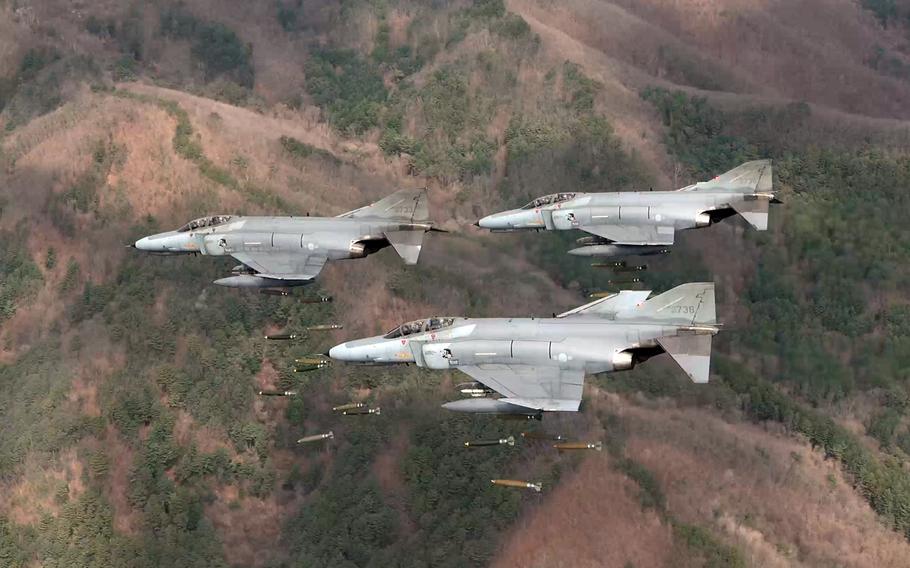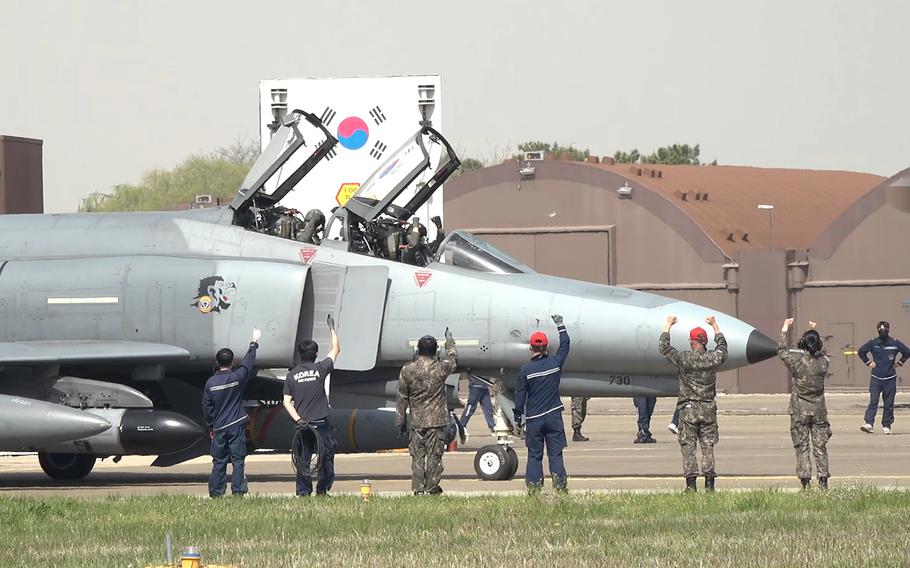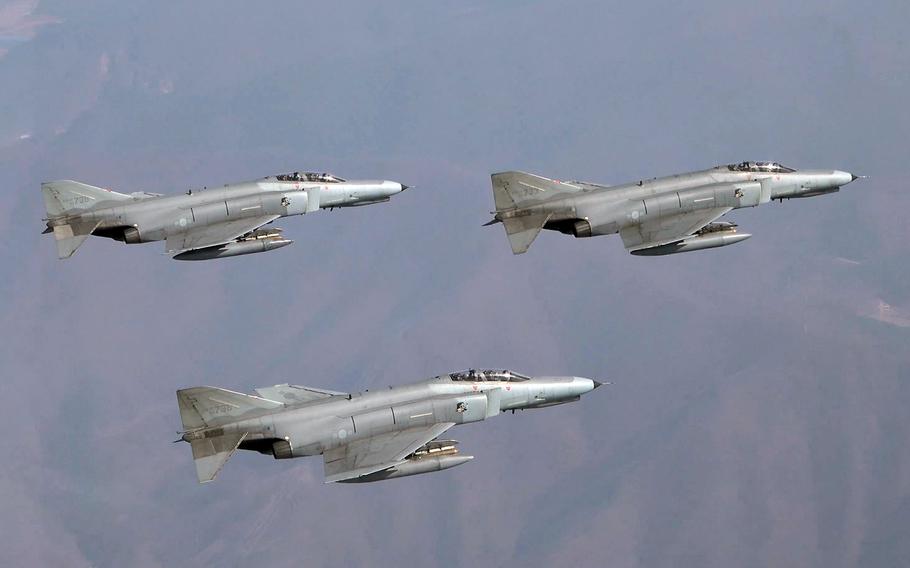
South Korean air force F-4 Phantom IIs drop 500-pound MK-82 free-fall bombs at an unspecific training site in South Korea, April 4, 2024. (South Korean air force)
SEOUL, South Korea — Some of the last F-4 Phantom IIs still flying released their final ordnance during live-fire drills this month, three weeks before South Korea retires the fighters after 55 years of service.
F-4s fired air-to-ground AGM-142 missiles and dropped 30 500-pound MK-82 free-fall bombs toward simulated targets in recent weeks, the South Korean air force said in a news release Thursday. It was the final day of live-fire drills by Phantoms in South Korea.
The F-4 was developed in the 1950s for the U.S. Navy as a bomber and interceptor by the former McDonnell Aircraft Corp., of St. Louis.
It took its maiden flight in 1958; five years later, it was introduced to the Air Force as part of the Defense Department’s plan for identical fighter airframes across the service branches, according to the Air Force.
In the Vietnam War, the F-4 flew bombing runs, reconnaissance missions and air-to-air combat against North Vietnamese MiG-21s produced by the Soviet Union. Phantoms went on to carry out reconnaissance operations during Operation Desert Storm in the early 1990s. They also flew Wild Weasel missions, firing missiles at Iraqi air defense radar.

A South Korean air force F-4 Phantom II prepares to take off from an unspecified base in South Korea, April 18, 2024. (South Korean air force)
While blessed with impressive speed and the ability to handle many roles, “it didn’t do anything spectacularly,” Chuck Watson, a curator for the Combat Air Museum in Topeka, Kan., said by phone Sunday.
Over Vietnam, U.S. pilots discovered the big, twin-engine, two-seat Phantom was less maneuverable than the single-seat, single-engine MiG-21, and suffered in dogfights as a result.
“A lot of people were shocked that we went back to a two-man concept because a lot of aircraft were going single-pilot,” Watson said.
The backseat crew member assisted the pilot in navigating and working the radio; however, their most important task during the war was to provide an “extra pair of eyes,” Watson said.
“The combat environment was so intense and there’s so much forced on the pilot at one time that they just couldn’t cope with all of it,” he said. “So having a second pair of eyeballs really helped in that situation.”
The military addressed some of the F-4’s deficiencies by reemphasizing aerial combat training for pilots and using the jet’s top speed of roughly 1,400 mph to its advantage, Watson said.
“You wouldn’t try to turn with the MiG but the Phantom had so much excess power that it could set the field how it wanted to fight, especially when it went vertical,” he said. “It can easily light the afterburners, go straight up, scissor back down and get behind the MiGs.”

South Korean air force F-4 Phantom IIs prepare to drop 500-pound MK-82 free-fall bombs at an unspecific training site in South Korea, April 4, 2024. (South Korean air force)
Nearly 5,200 F-4s were produced between 1958 and 1979, according to the Air Force. The U.S. military retired the aircraft in the early 1990s.
The last Phantom in the U.S. inventory — a remotely controlled QF-4 aerial target — made its final flight on Dec. 21, 2016, at Holloman Air Force Base, N.M.
The F-4 was South Korea’s premier fighter from 1969 until it began producing the homegrown KF-16, patterned after the U.S. F-16 Fighting Falcon, in 1994.
South Korea operated about 220 F-4s at its peak; today, that number is roughly 10, a Ministry of National Defense spokesman said by phone Friday.
The South Korean air force plans to retire the aircraft during a ceremony at South Korea’s Suwon Air Base on June 7.
South Korean officials customarily speak to the media on condition of anonymity.
Only Iran, Turkey and Greece still fly the venerable fighter, according to a Feb. 10 article on the Simple Flying website.
“It’s got a tremendous following of people,” Watson said of the F-4. “If I was wealthy and had nothing but time, I’d find my way over there to watch it fly one more time.
“When they’re all gone, there won’t be another like it,” he said.